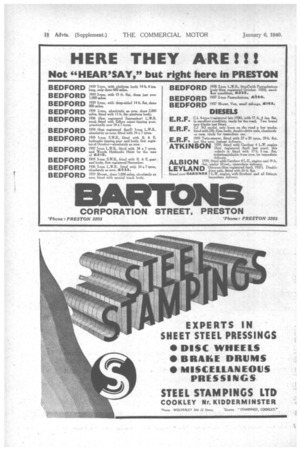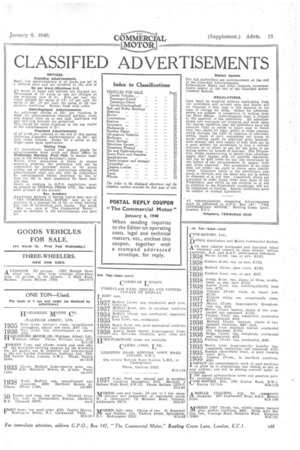Capacity Need Not Detract
Page 44

Page 45

If you've noticed an error in this article please click here to report it so we can fix it.
From Appearance in
FURNITURE VANS
THE requirements of the furniture manufacturer are similar to those of the remover, and both. make use of vans of large capacity. Some manufacturers, however, still prefer the open lorry, usually with a large platform built over the cab, but in due course, no doubt, these operators will turn to the covered type so that the load will be well protected from the weather.
A van suitable either for transport between factory and warehouse or shop, or for removal work, has about 9 ft. 6 ins, of headroom and there is a good height inside the Luton-type front. Instead of this over-cab floor terminating at the front bulkhead, it is extended beyond it for another 4 ft. or 5 ft. This part of the upper deck is not usually the full width of the body, but is open in the centre, in order to afford easy access all round.
Value of Front Doors • • on a Luton-type Van.
The rear end of the upper deck may be supported on cross-partitions of corresponding width. The front of the van, between the bulkhead and these partitions, is accessible not only from the rear but from the side of the vehicle, where there is a pair of doors.
The whole of the body may be built as a boxvan, or the rear portion, behind the side doors and upper deck, may have hoops and a loose sheet.
The semi-trailer ot the articulated vehicle provides scope for bodywork of maximum capacity, with a low floor behind the turntable bearing. The front of the body should be B38 rounded so that it clears the back of the cab at any angle of lock, or any variation of road surface. This rounded front may be sloped above the cab-roof level and then merged into a domed roof so that an attractive streamlined effect is obtained. At the rear, the corners can be rounded and the back shaped, there being a tailboard with a roller shutter above it.
The body, above the turntable, has a sliding door which covers an opening about 6 ft high and 4 ft. wide. In order to provide a wide opening,
the door casing (and the top and bottom bearings for the door) extend a few inches into the body, behind the turntable.
The house furnisher may make more intensive use of his van if it be designed to serve the dual purpose of a delivery van and a travelling showroom. The body could have an outline similar to that of a pantechnicon, but the floor would be above the rear wheels so as to avoid the use of obstructing wheel-arches. The framework would be of metal, in order that the pillars and raves might be of the smallest dimensions, whilst the whole of the side of the body, from floor to cant-rail, would be glazed with toughened glass.
The back doors, also, could have glass panels. A deep skirt panel would provide space for writing display, apart from any lettering, removable boards or posters_ which might be on the cab superstructure. When such a van be required for
ordinary delivery purposes, plain panels are fixed inside the van, behind the glass. For ease of handling these panels might be in units of two or three, for each side of the body. They could be inserted at the bottom, behind a floor fillet, and fixed at the top with butterflyheaded screws. Such panels would
be of plywood, reinforced with battens at the back. Panels might be fixed to the insides of the doors, or they could be removed, and panelled doors substituted.
The floor could be fixed or of false type, so that, when removed, it would reveal a second floor at a lower level, with the usual squared-up wheel-arches. There would be a sliding door in the front bulkhead.
Some house furnishers use a small 'ran for special deliveries of a few articles, or for carrying linoleum or carpets and such a van, like the larger showroom just described, might also be used for publicity purposes.
The loading portion of the body would be built to resemble a sideboard—in this instance double-sided. This particular piece of furniture is chosen because its outline approaches the rectangular. The roof would have curved sides and ends, to give an appearance similar to that of some modern sideboards. The front and hind corners might be square or rounded and • the enlarged model might be made to appear to stand on
(Left) Rear view of ti van body for piano transport, showing ramped floor and removable boarding to cover the ramp when a level floor throughout is required. (Below) Built for two purposes, this body can be used as a travelling furniture showroom, for which purpose it has glazed sides and back doors, or as a delivery unit.
legs, by recessing a lower panel and painting it a contrasting colour. As an alternative, the sideboard could have a plinth interrupted by the wheel-arch, or continued across a paddle-box panel.
The sideboard itself would have two drawers at the top and three cupboards below, both drawers and cupboards being dummies. The body might well be painted to resemble the natural grain of wood, or built with wooden panels, either in the solid or veneered.
A Way in Which to • Attract Customers. • As the majority of furniture manufacturers and retailers utilize the natural beauty of wood as a leading feature to attract the customer, it is suggested that such effects might be incorporated more often in the bodywork of their vans and lorries.
Although pianos are Often carried in pantechnicons, the vans specially designed to carry these instruments are usually without wheel-arches inside the body. If there be a tailboard, this is not usually used as a loading platform but the floor is sloped downwards, to the rear, behind the wheel-arch position.
• Thus, a lower and more convenient loading height is provided when the piano is brought on a trolley, laid on its back and slid into the van. If the whole length of the van be required for a second piano, then the ramp may be covered with boards.












































































